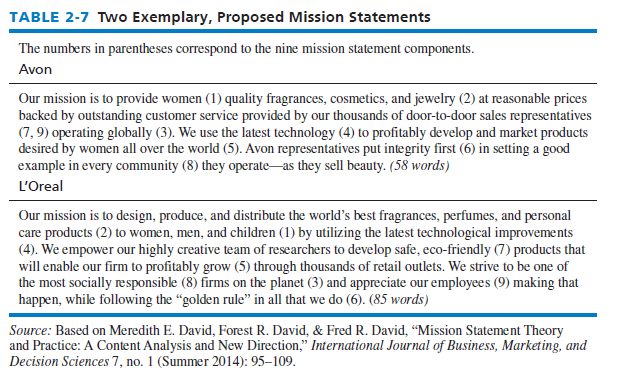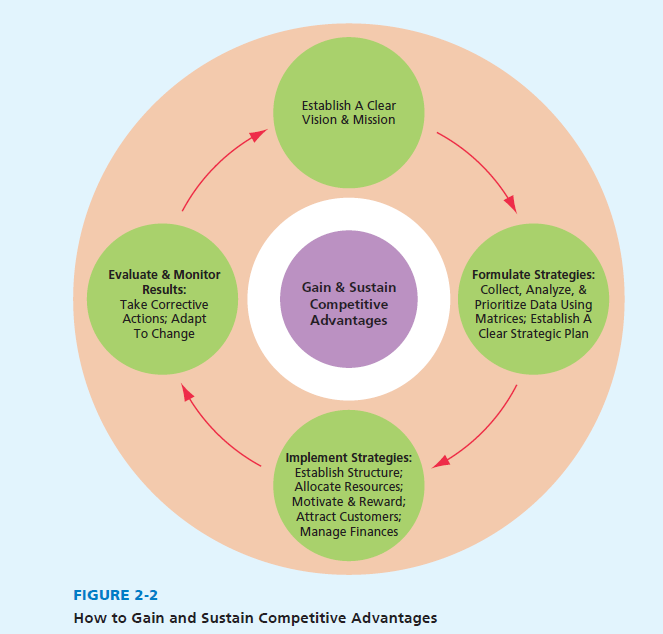There is no one best mission statement for a particular organization, so when it comes to evaluating mission statements, good judgment is required. Ideally, the statement will provide more than simply inclusion of a single word such as products or employees regarding a respective component. Why? Because the statement should motivate stakeholders to action, as well as be customer-oriented, informative, inspiring, and enduring.

1. Two Mission Statements Critiqued
Perhaps the best way to develop a skill for writing and evaluating mission statements is to study actual company missions. Thus, Table 2-5 provides a component-by-component critique of two actual mission statements from PepsiCo, and Royal Caribbean. the Royal Caribbean statement includes only six of the nine components, comprises 86 words total, and lacks a customer perspective. The Royal Caribbean statement merely includes the word customer(s), which is inadequate to be considered written from a customer perspective.
2. Five Mission Statements Revised
As additional guidance for practitioners (and students), five actual mission statements are revised/rewritten from a customer perspective and presented in Table 2-6. The improved statements include all nine components written from a customer perspective, and, additionally, are inspiring, concise, and comprised of fewer than 90 words each. regarding the “customer” component, the new Best Buy statement refers to “individuals and businesses”; the new Lowe’s statement refers to “homebuilders and homeowners”; and the improved Crocs statement refers to “men, women, and children.” In contrast, the Crocs, Best Buy, Rite Aid, and Lowe’s actual statements merely include (or not) the word customer or consumer. The statements are revised to potentially enhance customer satisfaction, especially if communicated to customers by marketers, and backed by company commitment to and implementation of the mission message. The proposed statement for the footwear company Crocs, Inc., for example, talks about “dependable and lasting comfort all day,” whereas the UPS proposed statement talks about “the most timely, dependable, and accurate delivery times in the world.”
3. Two Mission Statements Proposed
The process by which mission statements are developed and the exact language/wording included in the statement can significantly impact their effectiveness as a tool for strategic management and marketing strategy. Firms strive to have customers exhibit an emotional bond with the firm’s products/services and be “on a mission” to use and promote those offerings. Mission statements should be developed and used to foster customer satisfaction and create a bond between a firm and its customers. Involving marketers and sales representatives in the mission statement development process, coupled with including the nine components written from a customer perspective, could enable firms to create an emotional bond with customers, and enhance the likelihood that salespersons would be “on a mission” to provide excellent customer service. Avon and L’Oreal’s customers, for example, often portray an emotional bond or attachment to the firm’s products.


Proposed, exemplary mission statements for Avon and L’Oreal are provided in Table 2-7. These rival firms have uniquely different competitive advantages in that Avon utilizes door-to-door sales representatives to gain competitive advantage, whereas L’Oreal markets products in thousands of retail outlets. The proposed Avon and L’Oreal statements have the characteristics described earlier, and include the nine components written from a customer perspective. The proposed Avon statement includes the nine components in 58 words, and provides a basis for an emotional bond to be established between the firm and its customers. For example, the Avon statement reveals that if you purchase Avon products, you will be rewarded with “outstanding customer service provided by a personal sales representative who adheres to the highest ethical standards, while providing fragrances, cosmetics, and jewelry that exhibit the highest technological advancements.” There is quite a lot in that brief statement that an Avon customer can become loyal to, especially when the Avon marketing representative reinforces the statement with her actions.

Also written from a customer perspective, the proposed L’Oreal mission statement provides a basis for an emotional bond to be formed between the firm and its customers. Potential customers are reassured in the statement that the L’Oreal’s fragrances, perfumes, and personal care products are “organic” and developed by excellent teams of researchers. In addition, the statement reveals that L’Oreal does great philanthropy work and follows the “golden rule” in all endeavors. Customers may become more dedicated to L’Oreal when they see the company’s marketing communications reinforce the basic content given in the proposed mission statement. Loyal customers are a competitive advantage for any firm.

Source: David Fred, David Forest (2016), Strategic Management: A Competitive Advantage Approach, Concepts and Cases, Pearson (16th Edition).

17 May 2021
17 May 2021
18 May 2021
18 May 2021
18 May 2021
17 May 2021